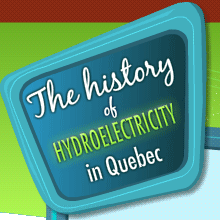Hydroelectric Generating Station
| Image | Description |
|---|---|
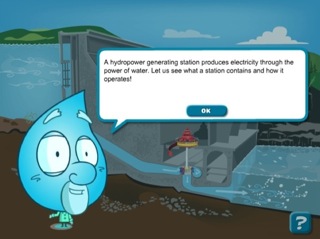 |
Description : Credits screen featuring a character in the form of a drop of water with a cartoon speech bubble presenting the introductory text. There is an "OK" button. There is a "?" button to return to the introductory page at any time. Transcription : The Hydropower Generating Station A hydropower generating station produces electricity through the power of water. Let us see what a station contains and how it operates! |
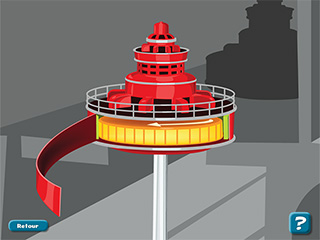 |
Description : When we click on the generator, we go directly to this screen. The screen represents the generator and its different components. When we move the mouse over a component, its definition appears onscreen. There is a "Return" button There is a "?" button to return to the introductory page any time. Transcription : Generator 1 Rotor Mobile section of the generator covered with electromagnets fed by an exciter. The rotor turns inside the stator, thanks to the rotation of the turbine shaft set in motion by the force of the turbine. 2 Stator Stationary section of the generator, made up of copper windings. 3 Exciter Piece of equipment located at the top of the generator. The exciter is made up of a rotor and a stator. Its function consists of producing a direct current to feed the rotor's electromagnets. 4 Copper Windings Windings facing the rotor's electromagnets. Cooper is a good electrical conductor. |
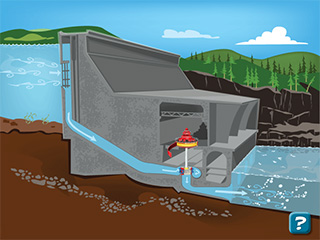 |
Description : Image representing a cross-section of a generating station so we can see the components inside the generating station. When we move the mouse over a component, its definition appears onscreen. There is a "?" button to return to the introductory page any time. Transcription : 1-Dam Structure generally made of concrete built on a riverbed to retain and accumulate water to be used to produce electricity. 2-Reservoir Area where water retained by the dam is stored to produce electricity. 3-Water Intake This is a structure that directs water from the reservoir or river to the penstocks. Debris traps prevent the entry of debris. 4-Penstock This is a huge metal pipe, concrete channel or channel carved in rock that directs water from the intake to the turbine scrollcase. 5-Turbine Piece of equipment made of steel and equipped with a metal scrollcase. The power of water causes the scrollcase to turn. The turbine transforms the energy of water into mechanical energy, causing a shaft to rotate and power the generator. 6-Generator This piece of equipment is the only component to produce electricity at the generating station. The generator is made up of a rotor and a stator. Rotating the rotor causes electrons in the copper windings in the stator to vibrate, creating an electric current. 7-Tailrace Structure that redirects water flowing through the turbine to the natural course of the river. |
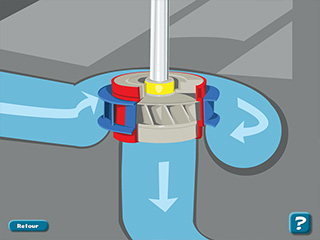 |
Description : When we click on the turbine, we go directly to this screen. The screen represents the turbine and its different components. When we move the mouse over a component, its definition appears onscreen. There is a "Return" button There is a "?" button to return to the introductory page any time. Transcription : Turbine 1-Wicket Gate Helical-shaped conduit around the scrollcase that ensures consistent water distribution. The wicket gate directs water from the penstock to the turbine's scrollcase. 2-Scrollcase Mobile component of the turbine mounted horizontally on the turbine shaft. The scrollcase is powered by the flow of water. It causes the shaft to spin and rotate the generator. 3-Turbine Shaft This piece of equipment connects the turbine to the generator. The shaft transmits the mechanical energy of the turbine to the generator's rotor. Set in motion by the turbine scrollcase, the shaft causes the rotor to spin. 4-Draft Tube Located under the turbine, it evacuates water while diminishing its flow towards the tailrace. |
